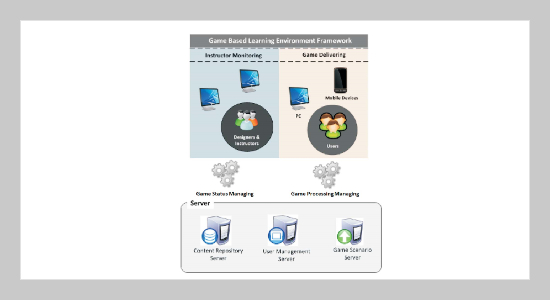REFERENCES
- [1] Pasin, Federico and Giroux, Hélène., “The Impact of a Simulation Game on Operations Management Education,” Computers & Education, Vol. 57, pp. 1240– 1254 (2011). doi: 10.1016/j.compedu.2010.12.006
- [2] Lin, F. H., Kinshuk and Dutchuk, M., “Multi-agent Architecture for Integrating Adaptive Features in Immersive 3D Virtual Learning Environments,” Proceeding of the 6th International Workshop on Mobile and Ubiquitous Learning Environment, pp. 3335 (2009).
- [3] Clark, D. and Linn, M. C., “Designing for Knowledge Integration: The Impact of Instructional Time,” The Journal of Learning Science, Vol. 12, No. 4, pp. 15 142 (2003). doi: 10.1207/S15327809JLS1204_1
- [4] Chang, C. S. and Huang, Y. P., “Usability Assessment of E-café Simulation Game-based Material,” Proceedings of 7th International Conference on E-Learning, IADIS, Taiwan, Taipei (2013).
- [5] Charsky, D., “From Edutainment to Serious Games: A Change in the Use of Game Characteristcs,” Game and Culture, Vol. 5, pp. 177198 (2010). doi: 10.1177/ 1555412009354727
- [6] Tompson, G. H. and Dass, P., “Improving Students’ Self-efficacy in Strategic Management: The Relative Impact of Cases and Simulations,” Simulation and Gaming, Vol. 31, pp. 22–41 (2000). doi:10.1177/ 104687810003100102
- [7] Bai, H., Pan, W., Hirumi, A. and Kebritchi, M., “Assessing the Effectivenss of a 3-D Instructional Game on Improving Mathematics Achievement and Motivation of Middle School Students,” British Journal of Educational Technology, Vol. 43, No. 2, pp. 9931003 (2012). doi: 10.1111/j.1467-8535.2011.01269.x
- [8] Cheng, M. T., She, H. C. and Annetta, L. A., “Game Immersion Experience: Its Hierarchical Structure and Impact on Game-based Science Learning,” Journal of Computer Assisted Learning, pp. 232253 (2015). doi: 10.1111/jcal.12066
- [9] The Design-Based Research & Collective, “Designbased Research: An Emerging Paradigm for Educational Inquiry,” Educational Researcher, Vol. 32, No. 1, pp. 58 (2003) doi: 10.3102/0013189X032001005
- [10] Collins, A., Joseph, D. and Bielaczyc, K., “Design Research: Theoretical and Methodological Issues,” The Journal of the Learning Science, Vol. 13, No. 1, pp. 15–42 (2004). doi: 10.1207/s15327809jls1301_2
- [11] Pardo-Ballester, C. and Rodri’guex, J. C., “Using Design-based Research to Guide the Development of Online Instructional Materials,” In C. A. Chapelle, H. G. Jun, & I. Katz (Eds.), Developing and evaluating language learning materials. Ames, IA: Iowa State University. pp. 88102 (2009).
- [12] Yutdhanna, S., Design Based Research in Call, in J. Egbert and G. M. Petrie (eds), CALL Research Perspectives, Mahwah, NJ: Lawrence Erlbaum and Associate, pp. 169178 (2005).
- [13] Hardash, J., Hamilton, B. and Dunn, M., “GPS III Independent Program Assessment Lessons Learned - From IPA Failure to Mission Success,” Proceeding of IEEE Aerospace Conference, MT, U.S.A, Mar. 0714, pp. 110.(2009). doi: 10.1109/AERO.2009.4839717
- [14] Zhang, G., Xiong, F. and Luo, Q., “Research on Mobile English Assistant Learning System Based on Wireless Communication,” The Proceeding of 2nd International Conference on Pervasive Computing and Applications, pp. 689692 (2006).
- [15] Hong, N. S., McGee, S. and Howard, B. C., The Effect of Multimedia Learning Environments on Well-Structured and Ill-structured Problem-solving Skills, ERIC: ED474443 (2000).
- [16] Wang, F. and Hannafin, M. J., “Design-based Research and Technology-enhanced Learning Environments,” Educational Research & Development, Vol. 53, No. 4, pp. 5–23 (2005).
- [17] Perterson, R. and Olney, I., “Usability Evaluation in a Multiphase, Exploratory Design-based Research Study of an Online Community for the Practice of Special Education in Bulgaria,” Proceedings of ED-MEDIA 2009: World Conference on Educational Multimedia, Hypermedia & Telecommunications. Chesapeake, VA (2009).
- [18] Hartson, H. R., Andre, T. S. and Williges, R. C., “Criteria for Evaluating Usability Evaluation Methods,” International Journal of Human-Computer Interaction, Vol. 15, No. 1, pp. 145–181 (2003). doi: 10.1207/ S15327590IJHC1304_03
- [19] Rubin, J., Chisnell, D. and Spool, J., Handbook of Usability Testing: How to Plan, Design, and Conduct Effective Tests, 2nd edition. In: Wiley Publishing (2008).
- [20] Rohn, J. A., Spool, J., Ektare, M., Multer, M. and Redish, J. G., “Usability in Practice: Alternatives to Formative Evaluations-evolution and Revolution,” In Proceedings of Conference on Human Factors in Computing Systems, Minneapolis, Minnesoda, U.S.A. (2002).
















